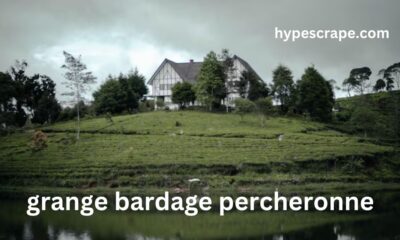TECHNOLOGY
The Rise of the Fapdemic: How Digital Culture is Shaping Sexual Behavior

The digital age has ushered in a profound transformation across various aspects of our lives, and sexuality is no exception. Enter the phenomenon dubbed the “Fapdemic.” This term captures a striking shift in how we explore, express, and engage with our sexual desires through technology. As screens become our go-to for connection and pleasure, it’s essential to understand how this cultural wave shapes not just individual behaviors but societal norms as well. Let’s dive into the fascinating world where virtual encounters meet real-life implications, revealing both the exhilarating possibilities and potential pitfalls of modern sexuality.
The Impact of Technology on Sexuality
Technology has redefined the landscape of human sexuality. With a tap on a screen, access to an abundance of information and experiences awaits. From explicit content to educational resources, digital platforms have changed how we learn about sex.
The anonymity of the internet allows for exploration that was once shrouded in stigma. People feel freer to express their desires without fear of judgment. This newfound liberation fosters open dialogue around topics previously considered taboo.
However, this convenience comes with its challenges. The prevalence of curated images can distort perceptions of intimacy and beauty standards. Real-life connections may suffer as virtual interactions become more common.
Moreover, technology often blurs boundaries between fantasy and reality. As individuals engage more online, they might find themselves navigating complicated emotions when it comes to genuine relationships. Balancing these two worlds is crucial for healthy sexual expression today.
The Evolution of Online Pornography
The landscape of online pornography has transformed dramatically over the last two decades. It began with simple text-based adult sites, which quickly evolved into an explosion of multimedia content. High-speed internet made it possible for users to access videos and images seamlessly.
As technology advanced, so did the sophistication of production. Today’s online porn offers high-definition visuals and complex storylines that cater to diverse preferences.
The rise of free content platforms disrupted traditional Adult Film industries. Users can find a vast array of genres at their fingertips without spending a dime. This accessibility has reshaped consumption habits.
Moreover, niche communities have emerged in response to varied interests within this space. Amateur performers now share their work alongside established stars, democratizing the industry and inviting new voices into the mix.
This evolution reflects broader societal changes around sexuality and expression in the digital age.
The Influence of Social Media on Sexual Behavior
Social media has transformed the way we express and explore sexuality. Platforms like Instagram, TikTok, and Snapchat foster an environment where sexual expression is more visible than ever. Users share everything from intimate photos to personal experiences.
This openness can both empower and pressure individuals. On one hand, it encourages self-acceptance and body positivity. On the other hand, it sets unrealistic standards for beauty and desirability that many feel compelled to meet.
The rise of influencers also plays a significant role in shaping perceptions around sex. Their curated lives might glamorize certain behaviors while trivializing others. Consequently, followers may find themselves mimicking these trends without understanding their implications.
Furthermore, social media creates spaces for communities focused on various sexual identities or fetishes. These groups provide support but can also lead users down paths of comparison or obsession with online validation rather than authentic connections offline.
Dating Apps and Hookup Culture
Dating apps have transformed the landscape of modern relationships. With a swipe and a tap, potential partners are just a heartbeat away. This ease of access has fueled hookup culture like never before.
People often seek instant gratification. The thrill of connection is enticing, yet fleeting. Many users find themselves navigating a maze of casual encounters rather than meaningful intimacy.
These platforms promote an array of choices, but they can also lead to decision fatigue. Users may feel overwhelmed by endless profiles and options that seem to blur the lines between love and lust.
Communication becomes shorthand as emojis replace words. This rapid exchange might foster connections, but it also risks misunderstanding and superficiality in interactions.
As dating apps continue to evolve, so does our understanding of relationships in this digital age—navigating desires while seeking genuine connections remains complex.
Virtual Intimacy: Long-Distance Relationships and Sexting
Virtual intimacy has revolutionized how couples connect, especially in long-distance relationships. Technology bridges the gap, allowing partners to share moments despite physical separation.
Sexting plays a significant role in this dynamic. It fosters closeness and enhances desire through shared fantasies and experiences. Texts can convey emotion and passion that might be harder to express face-to-face.
Video calls add another layer of connection. Seeing each other’s expressions creates an intimate atmosphere often lost in traditional messaging. Couples can engage in virtual dates or simply enjoy time together over screens.
However, it also brings challenges. Misunderstandings can arise from lack of non-verbal cues. Trust is crucial when sharing personal content online; breaches of trust can lead to severe consequences for relationships.
The balance between digital interaction and real-world connections is essential as we navigate this landscape of modern love.
The Dark Side of the Fapdemic: Addiction and Disconnect from Real-Life Relationships
The Fapdemic isn’t just a trend; it’s a growing concern. As digital culture flourishes, many feel the grip of addiction tightening around their daily lives.
Constant access to explicit content can lead to compulsive behaviors. What starts as casual viewing can spiral into something far more consuming. This pattern often leaves individuals feeling isolated and disconnected from real intimacy.
Relationships suffer in silence while people find solace behind screens rather than in the arms of loved ones. The gap widens between what’s virtual and what’s tangible, creating an emotional void that few acknowledge.
Moreover, this detachment is not merely physical but psychological too. People may struggle with understanding genuine affection or connection when they are constantly exposed to curated fantasies instead of reality.
Navigating through these challenges requires awareness and effort—qualities that are often overshadowed by the allure of instant gratification found online.
Navigating the Digital Landscape: Tips for Maintaining Healthy Sexual Habits
Set boundaries for your digital consumption. Be aware of how much time you spend engaging with sexual content online. It’s easy to lose track of time when scrolling through endless feeds.
Educate yourself about healthy relationships and communication. Understanding consent, respect, and emotional connection is vital in both digital and real-life interactions.
Consider scheduling “digital detox” days where you step away from screens entirely. This can help reset your mind and foster more genuine connections with others.
Engage in activities that promote well-being—exercise, hobbies, or spending time outdoors can shift your focus away from the screen.
Don’t hesitate to seek professional guidance if needed. Therapists specializing in sexual health can provide valuable insights into maintaining balance amidst the fapdemic culture thriving online.
Conclusion
The Fapdemic reflects a significant shift in how we engage with sexuality. Technology has redefined intimacy, creating new opportunities and challenges alike. As we navigate this digital landscape, it’s crucial to be aware of the implications for our sexual behavior.
While online platforms offer anonymity and convenience, they can also lead to addictive behaviors or a disconnect from real-life interactions. Understanding these dynamics is essential for cultivating healthy relationships—both online and offline.
By fostering open conversations about sexuality and setting boundaries around technology use, individuals can maintain a balanced approach. The key lies in embracing the benefits of digital culture while remaining grounded in authentic human connections. It’s possible to thrive amidst the complexities of modern intimacy if one stays mindful of their habits and choices.
As society continues to evolve alongside technology, so too will our experiences with sex and relationships. Staying informed empowers us all to navigate this brave new world thoughtfully, ensuring that connection remains at its core amidst the rapid changes surrounding us.
TECHNOLOGY
hypescrape.com Analysis of the December 2024 Website

Welcome to our December review of hypescrape.com, where we examine the site’s growth tactics, performance insights, and content trends. This study will give you useful information whether you’re a frequent reader, a new visitor, or a member of the Hype Scrape team looking to expand the platform’s audience.
What is hypescrape.com?
The WordPress-powered site hypescrape.com offers a variety of articles in areas like lifestyle, technology, health, and real estate. By offering interesting topics to a wide audience, the platform positions itself as a go-to source for thought-provoking articles and educational blogs.
From discussions on healthcare strategies to decoding current real estate market dynamics, hypescrape.com’s ability to cover timely and relevant subjects has fostered a growing readership.
Highlights from December 2024 Content
Let’s take a closer look at the latest content categories and standout blog posts from December:
1. Real Estate
Top Post: Understanding the Dynamics of the Real Estate Market Right Now (updated 12 hours ago)
This blog explores the elements influencing real estate values, including:
An increase in interest rates
Gaps in housing supply
Changes in the economic landscape
This post offers insightful information about market trends, making it highly relevant in today’s real estate debates, as many homeowners and investors are looking for advice.
Why it Works:
- Timely topic with high search demand.
- Practical advice for its audience.
2. Technology
Top Post: Chain-Labs Design: The Art and Impact (Posted two weeks ago)
The article addresses innovation and creativity in technology by examining how functionality and design intersect in chain-labs. This niche topic offers a unique perspective, attracting readers interested in cutting-edge industry trends.
Why it Stands Out:
- Focus on innovation captures a forward-thinking audience.
- Coverage of a specialized topic highlights subject matter expertise.
3. Health and Wellness
Top Post: Vasectomy Advantages You Need to Know Before Deciding (Posted 1 week ago) This article breaks down major variables and considerations for individuals investigating vasectomy as a birth control procedure. Topics include safety, effectiveness, and long-term benefits.
Why It Resonates:
- Provides clear, actionable information on a deeply personal decision.
- Positions the platform as a trusted source for health advice.
4. Lifestyle and Culture
Top Post: The Magic of Love2Love.lv (Posted 4 days ago)
A deep look at a dating platform offering something different in the crowded online dating market. The blog connects with readers on the ubiquitous challenge of finding meaningful connections.
Audience Appeal:
- Focuses on a relatable theme for modern audiences.
- Taps into an evergreen topic with wide appeal.
Content Performance Insights
Analyzing the content from hypescrape.com shows noteworthy performance patterns:
Diverse and Relevant Niches
By covering areas like real estate, health, and technology, hypescrape.com successfully attracts a diverse readership. The key lies in maintaining relevance and offering evergreen and timely content.
Actionable Tip: Harness keyword tools to identify trending topics for future posts. For example, current terms like “AI in real estate” or “health tech breakthroughs” could pull in even more traffic.
Blog Post Frequency
A regular publishing cadence (e.g., two posts per week in December) keeps the audience engaged and improves search engine visibility. The platform does well to ensure steady content output.
Actionable Tip: Consider posting interactive content (like polls or quizzes) to keep readers coming back.
SEO Optimization Potential
Content headline formatting, like “Decoding Current Real Estate Market Dynamics,” reflects an attempt at SEO alignment. However, meta descriptions and internal linking strategies could be further enhanced.
Actionable Tip: Refine meta descriptions with compelling, keyword-rich summaries and increase internal links between related blogs to boost time spent on the site.
Growth Opportunities for hypescrape.com
To ensure its continued growth, here are some strategic recommendations tailored for hypescrape.com:
Strengthen Community Engagement
A comments section can be a goldmine for boosted interaction and organic keywords, yet we noticed “No comments to show” under recent posts. Encouraging comments can foster conversation and a sense of community.
Action Tip: Call readers to action in social posts and articles by asking specific questions like, “What are your thoughts on X?” or “Share your experiences in the comments below.”
Focus on Social Media Promotion
Leveraging social media channels will amplify traffic and brand visibility. Content like “The Magic of Love2Love.lv” would perform well on visual platforms like Instagram, while pieces like “Decoding Current Real Estate Market Dynamics” fit well on LinkedIn.
Actionable Tip: Create shareable infographics and highlight intriguing blog excerpts to drive clicks from social platforms.
Optimization for Mobile
Given the rise of mobile browsing, ensuring that hypescrape.com is fully mobile-friendly is critical. Content should load quickly and remain accessible on smaller screens.
Actionable Tip: Conduct regular mobile usability checks to ensure layouts and formatting appear seamless for all devices.
Enhance Email Marketing
An on-site email subscription feature opens a channel to send readers timely updates about new blogs or trending topics.
Actionable Tip: Offer a quick freebie (like a PDF guide summarizing key real estate trends) in exchange for sign-ups.
The Path Ahead for hypescrape.com
hypescrape.com has built a solid foundation by delivering diverse, engaging blogs tailored to current consumer interests. However, to stay competitive and scale, the platform should lean into audience engagement strategies, improved SEO tactics, and targeted promotions.
Whether it’s transforming readers into active community members or breaking into niche tech conversations, making small adjustments will yield big results.
TECHNOLOGY
Elegance Meets Innovation in the www.goodmooddotcom.com luxury category

In a world where style and functionality often collide, the www.goodmooddotcom.com luxury category stands as a beacon of where elegance meets innovation. This exclusive range is not just about high-end products but about redefining what luxury can mean in our modern age. For those who appreciate the finer things in life, this collection promises to deliver both aesthetic pleasure and cutting-edge innovation.
The New Face of Luxury
Luxury today is not just about opulence; it’s about offering solutions that enhance lifestyle while maintaining an air of sophistication. At www.goodmooddotcom.com luxury category, luxury is seen through a lens that values innovation just as much as it does tradition. The products in this category are meticulously curated to ensure they not only meet but exceed the expectations of discerning consumers.
Each item is selected with a focus on quality, design, and functionality. Whether you are seeking to elevate your home décor or looking for the perfect gift, the luxury category offers something unique for every taste and occasion. With a range of options that prioritize both form and function, GoodMoodDotCom is setting new standards in the luxury market.
Why Innovation Matters in Luxury
Innovation is the driving force behind GoodMoodDotCom’s luxury category. In today’s fast-paced world, consumers expect more than just beauty; they want products that integrate seamlessly into their lives. This means luxury goods need to be intuitive, multifunctional, and environmentally conscious.
GoodMoodDotCom embraces this ethos by offering products that bring innovative technology and sustainable practices to the forefront. From smart home devices to eco-friendly materials, each item in the collection is designed to make life easier and more enjoyable. This commitment to innovation ensures that luxury is not just a status symbol but a meaningful part of everyday life.
A Curated Collection of Elegance
Every product in GoodMoodDotCom’s luxury category is carefully chosen to reflect the highest standards of elegance. This is not just about aesthetics but about creating an experience that transcends the ordinary. The collection includes:
- Timeless Accessories that add a touch of sophistication to any outfit or occasion.
- Innovative Homeware that combines style with functionality, making your living space both beautiful and practical.
- Exclusive Beauty Products that employ the latest technology to ensure you look and feel your best.
This curated selection not only offers variety but also ensures that each purchase is a step towards creating a personal sanctuary of luxury.
The Art of Fine Living
Living luxuriously is an art, and www.goodmooddotcom.com luxury category provides the palette needed to paint your life with elegance and ease. The luxury category is not about indulgence for indulgence’s sake; it’s about enhancing the quality of your everyday experiences. With pieces that inspire and innovate, you can transform your environment into a reflection of your personal style and values.
From statement pieces that command attention to subtle accents that enhance your daily routine, the luxury category is designed to cater to the multifaceted nature of modern living. By blending tradition with innovation, GoodMoodDotCom helps you create a lifestyle that is both refined and forward-thinking.
Quality You Can Trust
When it comes to luxury, quality is paramount. GoodMoodDotCom ensures that every product in their luxury category is crafted with the utmost care and attention to detail. This dedication to excellence guarantees that each item not only looks exquisite but is built to last.
Whether you are purchasing a piece of jewelry or a state-of-the-art gadget, you can trust that GoodMoodDotCom is committed to providing products that uphold the highest standards. This promise of quality is supported by a rigorous selection process and partnerships with leading designers and manufacturers.
Sustainability Meets Sophistication
Incorporating sustainable practices into luxury goods is a priority for www.goodmooddotcom.com luxury category. The luxury category is committed to reducing environmental impact by offering products that are both beautiful and kind to the planet. From responsibly sourced materials to eco-friendly packaging, every effort is made to ensure sustainability without compromising on style.
This focus on sustainability means you can indulge in luxury with a clear conscience, knowing that your choices contribute to a better future. GoodMoodDotCom believes that true luxury is not only about enjoying the best in life but about making choices that reflect a commitment to the planet and future generations.
Engaging the Senses
The luxury category at GoodMoodDotCom is designed to engage all the senses, offering a holistic experience that transcends traditional consumerism. Each product is intended to evoke emotion and inspire creativity, whether through its design, functionality, or story.
By focusing on multi-sensory experiences, GoodMoodDotCom invites you to explore luxury in a new and immersive way. This approach ensures that each piece resonates on a deeper level, providing not just a product but an experience that enriches your life.
Building a Community of Connoisseurs
GoodMoodDotCom is more than just a marketplace; it is a community of like-minded individuals who appreciate the finer things in life. By joining this community, you become part of a network that values quality, innovation, and elegance.
Through exclusive events, newsletters, and collaboration opportunities, GoodMoodDotCom fosters a sense of belonging among its customers. This community aspect adds another layer to the shopping experience, providing insights, inspiration, and connections that enhance your appreciation of luxury.
Future Trends in Luxury
The future of luxury is bright at www.goodmooddotcom.com luxury category, with constant advancements in technology and design pushing boundaries and redefining what is possible. The luxury category is continuously evolving to meet the changing needs and desires of consumers, ensuring that it remains at the forefront of industry trends.
From smart technology integrations to sustainable innovations, the future looks promising for those who choose to explore the luxury category at GoodMoodDotCom. This forward-thinking approach guarantees that you will always have access to the latest and greatest in luxury offerings.
Crafting Your Luxury Lifestyle
Creating a luxury lifestyle is a personal and rewarding endeavor, and GoodMoodDotCom is here to guide you on that journey. With a diverse range of products that cater to various tastes and preferences, you can curate a collection that speaks to your individuality and enhances your way of living.
Whether you are looking to make a bold statement or seek understated elegance, the luxury category provides the tools you need to craft a lifestyle that is uniquely yours. This commitment to personalization ensures that your experience is as exceptional as the products themselves.
Conclusion
In conclusion, the www.goodmooddotcom.com luxury category offers a unique blend of elegance and innovation, catering to those who seek more from their purchases. By prioritizing quality, sustainability, and community, GoodMoodDotCom ensures that their luxury offerings are not just products but an experience that enriches lives.
For those who appreciate the artistry of fine living, the luxury category is an invitation to explore, indulge, and elevate every aspect of life. By choosing www.goodmooddotcom.com luxury category, you are not only investing in products of unparalleled quality but in a lifestyle that values elegance, innovation, and sustainability.
Explore the luxury category today and discover how GoodMoodDotCom can help you redefine your concept of luxury.
TECHNOLOGY
Why LED Strip Lights Are Perfect for Modern Home Décor?

Introduction: The Rise of LED Strip Lights in Modern Home Décor
LED strip lights have gained great popularity in today’s interior design, and for good reason.
They are incredibly versatile, energy efficient, and just plain beautiful. They do modern things to spaces that let you know you’re living in the present.
They do old-timey things in ways that feel nostalgic, like when they’re used to lighting up signs. They can be, and have been, used for residential, commercial, and industrial lighting solutions in spaces both private and public since their advent.
Here are a few ways we can think of that they can be, and are, used to illuminate the interiors of both homes and businesses.
The move away from conventional incandescent and fluorescent lighting and toward LED technology has been driven by the need for energy-efficient solutions. When it comes to true outdoor lighting, however, where the push is also toward more eco-friendly fixtures, the new go-to option has become bright led strip lighting.
Power-wise, they use a fraction of what other types of lighting use (half, or 16 cents per kilowatt-hour) and achieve a price tag that makes them far more cost-effective as well. Pros with landscape lighting perform the job of bringing the brightness and beauty of an LED strip light to the exterior of a home.
They also use the same light to create stunning color and light displays in bushes, trees, and plants. Adapting space so there isn’t an interior/exterior lighting discrepancy is something these pros do as well.
Understanding LED Strip Lights: Features & Benefits
Light-emitting diode (LED) strip lights are flexible circuit boards with small LED landscape light bulbs embedded along their length. When powered, these energy-efficient lighting devices emit light quite similarly to how incandescent or fluorescent lamps do, albeit in a more uniform fashion.
Unlike those lamp-style lighting solutions, however, LED strip lights are bedroom-tailored devices that can be molded, mounted, and otherwise outfitted to various spaces and surfaces.
LED strip lights have many advantages. One of their biggest is energy efficiency. Compared to incandescent bulbs, they consume far less power and give off far more light. That makes them an excellent choice for any kind of lighting where you want to save on your electricity bill.
They also do very well. If you have a dimming LED driver for your LED strip, that’s another way to get the most out of your energy-efficient lighting.
A major advantage of LED strip lights is their flexibility. They can be installed nearly anywhere—along ceilings, under cabinets, around furniture, even outside. They come in various colors and brightness levels, making them appropriate for both functional and decorative illumination.
Homeowners can select from warm or cool white tones for general lighting. But many choose RGB (red, green, blue) strips to create dynamic, colorful lighting that shifts and changes.
How LED Strip Lights Enhance Modern Home Aesthetics
LED strip lights are massively influencing the aesthetic appeal of contemporary homes. They make possible various styles of illumination in home spaces, like living rooms, bedrooms, and kitchens, that, while perhaps not altogether new, seem to be proliferating in a search for ideas about achieving something called “ambient lighting.”
Ambience, whether in the form of a candle or an LED strip, speaks to the totality of a space. When light can appear to be coming from any number of source types, the eyes and brains of inhabitants curve toward the pleasure centers of perception.For those looking to create a classic and elegant outdoor atmosphere, bistro light installations are perfect. These stylish, vintage-inspired lights add warmth and charm to any garden setting.
Another major application of LED strips is accent lighting. These lights are used to highlight architectural features, such as wall panels, staircases, and alcoves, that add depth and character to a room. Unlike gladiatorial lighting, which throws light around any old how and illuminates everything in its path, LED strip lights are better suited for creating a “wow” factor in parts of a room where you want a little more glamour (or at least, where you want the lighting to be noticed more).
One more main advantage is smart home integration. LED strip lights can be integrated with smart home systems, allowing homeowners to control the lights—changing their color, brightness, and even their on-off cycles—via mobile app or voice command. This enhances not just our convenience but also energy efficiency, because it enables us to fine-tune the LED strips to our actual lighting needs. For those looking to create a classic and elegant outdoor atmosphere, consider using bright led rope lights to highlight plants or pathways..
The Best Places to Use LED Strip Lights in Home Décor
LED strip lights can be used in various parts of a home to boost both function and looks. One of the most typical applications is kitchen under-cabinet lighting, where these lights lend visibility and an ultra-modern look to the space. By lighting the countertops, LED strips make the kitchen a much safer and more convenient place to work.
Another common location for LED strip lights is behind televisions and entertainment centers. When it comes to creating an immersive viewing experience, nothing comes close to the balance of colors that LED strip lights provide. Their soft glow helps to ease the strain on one’s eyes and, as such, increases the amount of time one can comfortably spend either binge-watching a new series or finishing up the latest level in a video game.
LED strips add depth and create a luxurious atmosphere in cove and ceiling lighting. Installed along crown molding or in recessed ceilings, they enhance the overall ambiance of a room, making it feel larger and more elegant.
To create a spa-like atmosphere, the lighting in the bathroom and around the mirror should utilize LED strips. This is because, in addition to being an energy-efficient alternative to incandescent bulbs and fluorescent tubes, LED strips provide the kind of clean, even light that makes mirrors truly functional. And if you want to take your bathroom to another level, consider placing LED strips inside your shower.
Strip lighting is well-suited for staircases and hallways. Improved visibility and safety are good reasons for putting any kind of light in a stairway, but the sleek form of an LED strip light means it can fit seamlessly near the edge of a step or at the top and bottom of a stairway without being obtrusive or interrupting the clean lines of a contemporary home design.
In a similar setup, an LED strip light can be and is used quite successfully in a dark hallway, again, if it’s not put right at the middle of the floor or if it’s right at the door, being the first light you see as you exit a room.For functional yet stylish pathways, brass path lights are ideal. They’re not only aesthetically pleasing but also provide essential illumination for safety.
Comparing LED Strip Lights with Other Lighting Solutions
Compared with standard bulbs, LED strip lights provide several benefits regarding energy use and appearance. Incandescent bulbs require a lot of power, and they generate huge amounts of waste heat, rendering them far less efficient than LED strips.
CFLs, while much better than incandescent bulbs in terms of energy efficiency, still fall short of the durability and flexibility of LED strip lights.
Another alternative to LED strips is recessed lighting. Recessed lights give a sleek and modern look, but they are not as easy to install as LED strips.
Furthermore, you have to be more concerned with where you are placing recessed lights, as you can only put them in certain areas. The flexibility of LEDs in location is part of what makes them such a good alternative to more traditional methods of lighting.
Traditionally used for decorative lighting, neon lights now face a modern alternative: LED strip lights. LED strips are durable and energy-efficient; they come in a wide range of colors, and they are no harder to install than regular old household lamps. So the question arises: Are LED strip lights a decent alternative to neon for home décor?
How to Choose the Right LED Strip Lights for Your Home
Selecting the perfect LED strip lights involves considering several key factors.
The measurement of brightness in lumens determines how intense the light is. Ideal for task lighting are high-lumen situations; for ambient lighting, concentrations of light are lower in lumens.
Another key aspect is color temperature. Warm white provides a cozy atmosphere, while cool white yields a bright and sharp appearance.
Homeowners need to determine if they will use waterproof LED strips or non-waterproof ones, and this decision should be based on where the strips will be located and what they will be used for. Use the shower? Then go with a waterproof strip. Outdoor space? Use a waterproof strip. Kicked it up a notch in the kitchen and drowned your sous-vide in all that delicious aqua? You need a waterproof light source.
Non-waterproof variants are decent and up to the task of lighting your indoor life and are considerably cheaper than their waterproof counterparts.
The kind of LED strip controller affects usability as well. Some LED strips come with remote controls; others integrate with smart home apps or use motion sensors to automate their lighting.
In addition, contractors who specialize in landscape lighting can help with the selection and placement of the ideal LED strips for use both inside and outside the home.
Professional Installation vs. DIY: What’s Best for Your Home?
There is much disagreement among homeowners about whether to put in LED strip lights all alone or get a pro to do it. The all-alone version isn’t too complicated, especially when it comes to plug-and-play LED strips.
But if you’re getting into some serious business, like hardwiring the strips or setting them up outdoors, now’s probably not the time to be a DIY hero.
Correct wiring, ideal positioning, and an overall seamless appearance are the hallmarks of professional installation. But landscape lighting contractors are also highly skilled at something else: design.
They can not only help you put all the elements of an effective lighting solution in the right places, either inside or outside a home, but they can also make (or help make) an effective lighting decision that serves the dual purpose of both illuminating and enhancing the space it occupies.
Maintenance and Longevity: Keeping LED Strip Lights in Top Condition
It is very important to maintain LED strip lights to ensure their longevity. Regular cleaning prevents dust and debris from affecting brightness. This, in turn, keeps the lights working effectively. And yet, there’s still quite a bit of life left in LED strip lights even after much use, provided they’ve been maintained.
So, how do you maintain them? It’s quite easy. A few simple steps, and you can call your LED strip lights well cared for.
Frequent problems like flickering or dimming can often be solved by examining the power source and ensuring proper installation. Over time, though, homeowners may need to replace certain sections or upgrade to newer, more efficient models to keep up with lighting trends.
Conclusion: The Future of LED Strip Lights in Modern Homes
Strip lights have become an essential part of contemporary home decor—a trend that’s only gaining in popularity. If you look up “LED strip lights” on TikTok, you’ll see a virtual cornucopia of on-trend lighting options offered.
From bathrooms and kitchens to the interior of your closet, there are endless places to put these bad boys, with endless possible looks. And most of them are plenty affordable.
With lighting technology moving forward, smart LED strips are bound to morph into the next generation, integrating with home automation systems.
To achieve what the manufacturers call an “indoor and outdoor cohesive lighting experience,” smart LED strip users should work with professionals in the lighting industry, particularly landscape lighting contractors.
-

 BLOG1 year ago
BLOG1 year agoEscape to Tranquility Experience Grange Bardage Percheronne in Normandy
-

 LIFESTYLE1 year ago
LIFESTYLE1 year agoAir Jordan 1 Retro High Off-White University Blue
-

 SOCIAL MEDIA1 year ago
SOCIAL MEDIA1 year agoDecoding the Drive Social Media Pyramid Scheme Mystery
-

 LIFESTYLE1 year ago
LIFESTYLE1 year agoAir Jordan 4 Retro Metallic Purple
-

 BLOG7 months ago
BLOG7 months agoDecoding 540-315-8592: From Numbers to Messages
-

 HOW-TO GUIDES1 year ago
HOW-TO GUIDES1 year agoShop Smart and Save with Goldengatemax.shop Online Guide
-

 BUSINESS1 year ago
BUSINESS1 year agoDemystifying 315-442-5267 Common Myths and Facts Revealed
-

 LIFESTYLE1 year ago
LIFESTYLE1 year agoAir Force 1 Shadow Pistachio Frost
